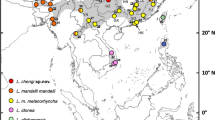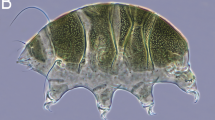Abstract
On the basis of distinguishing characteristics of various genetic markers, pelage color, tail tuft, and vocalizations, we describe a new species of the genus Tarsius Storr 1780. The new taxon Tarsius wallacei sp. nov. occupies a disjunct range in Central Sulawesi, Indonesia. The two isolated populations differ significantly in body size, but are alike in color, tail tuft dimensions, vocalizations, and genetic composition. Morphologically, the new species is similar to other Sulawesi lowland tarsiers. In the field, it can be distinguished from its congeners via a characteristic duet song and its yellow-brown pelage coloration and a copper-colored throat. Genetic analyses prove Y-chromosomal and mitochondrial DNA sequences and also microsatellite allele frequencies to be absolutely diagnostic.








Similar content being viewed by others
References
Brandon-Jones, D., Eudey, A. A., Geissmann, T., Groves, C. P., Melnick, D. J., Morales, J. C., et al. (2004). Asian primate classification. International Journal of Primatology, 25, 97–164.
Burton, J. A. & Nietsch, A. (2010). Geographical variation in duet songs of Sulawesi tarsiers: Evidence for new cryptic species in south and southeast Sulawesi. International Journal of Primatology. doi:10.1007/s10764-010-9449-8.
Erxleben, J. C. P. (1777). Systema Regni Animalis per Classes, Ordines, Genera, Species, Varietates, cum Synonymia et Historia Animalium. Classis I. Mammalia. Weygand, Leipzig.
Groves, C. P. (1998). Systematics of tarsiers and lorises. Primates, 39, 13–27.
Grow, N. B., & Gursky-Doyen, S. (2010). Preliminary data on the behavior, ecology, and morphology of Tarsius pumilus. International Journal of Primatology. doi:10.1007/s10764-010-9456-9.
Gursky, S., Shekelle, M., & Nietsch, A. (2008). The conservation status of Indonesia’s tarsiers. In M. Shekelle, I. Maryanto, C. Groves, H. Schulze, & H. Fitch-Snyder (Eds.), Primates of the oriental night (pp. 105–114). Jakarta: Indonesian Institute of Sciences (LIPI), LIPI Press.
Merker, S. (2003). Vom Aussterben bedroht oder anpassungsfähig?—Der Koboldmaki Tarsius dianae in den Regenwäldern Sulawesis. PhD dissertation, University of Göttingen, Germany.
Merker, S. (2006). Habitat-specific ranging patterns of Dian’s tarsiers (Tarsius dianae) as revealed by radiotracking. American Journal of Primatology, 68, 111–125.
Merker, S., & Groves, C. P. (2006). Tarsius lariang: A new primate species from Western Central Sulawesi. International Journal of Primatology, 27, 465–485.
Merker, S., Driller, C., Perwitasari-Farajallah, D., Zahner, R., & Zischler, H. (2007). Isolation and characterization of 12 microsatellite loci for population studies of Sulawesi tarsiers (Tarsius spp.). Molecular Ecology Notes, 7, 1216–1218.
Merker, S., Driller, C., Perwitasari-Farajallah, D., Pamungkas, J., & Zischler, H. (2009). Elucidating geological and biological processes underlying the diversification of Sulawesi tarsiers. Proceedings of the National Academy of Sciences USA, 106, 8459–8464.
Meyer, A. B. (1897). Säugethiere vom Celebes- und Philippinen-Archipel I. Abhandlungen und Berichte des Königlichen Zoologischen und Anthropologisch-Ethnographischen Museums zu Dresden, 6, 1–36.
Miller, G. S., & Hollister, N. (1921). Twenty new mammals collected by H. C. Raven in Celebes. Proceedings of the Biological Society of Washington, 34, 93–104.
Peakall, R., & Smouse, P. E. (2006). GENALEX 6: Genetic analysis in Excel. Population genetic software for teaching and research. Molecular Ecology Notes, 6, 288–295.
Shekelle, M. (2003). Taxonomy and biogeography of Eastern tarsiers. Ph.D.dissertation, Washington University, Saint Louis, MO.
Shekelle, M. (2008a). Distribution of tarsier acoustic forms, North and Central Sulawesi: With notes on the primary taxonomy of Sulawesi’s tarsiers. In M. Shekelle, I. Maryanto, C. Groves, H. Schulze, & H. Fitch-Snyder (Eds.), Primates of the oriental night (pp. 35–50). Jakarta: Indonesian Institute of Sciences (LIPI), LIPI Press.
Shekelle, M. (2008b). The history and mystery of the mountain tarsier, Tarsius pumilus. Primate Conservation, 23, 121–124.
Shekelle, M., & Leksono, S. M. (2004). Strategi konservasi di Pulau Sulawesi dengan menggunakan Tarsius sebagai flagship species [Conservation strategy in Sulawesi Island using Tarsius as flagship species]. Biota, 9(1), 1–10.
Shekelle, M., & Salim, A. (2009). An acute conservation threat to two tarsier species in the Sangihe Island chain [North Sulawesi, Indonesia]. Oryx, 43, 419–426.
Shekelle, M., Leksono, S. M., Ichwan, L. L. S., & Masala, Y. (1997). The natural history of the tarsiers of North and Central Sulawesi. Sulawesi Primate Newsletter, 4(2), 4–11.
Shekelle, M., Groves, C., Merker, S., & Supriatna, J. (2008a). Tarsius tumpara: A new tarsier species from Siau Island, North Sulawesi. Primate Conservation, 23, 55–64.
Shekelle, M., Morales, J. C., Niemitz, C., Ichwan, L. L., & Melnick, D. (2008b). Distribution of tarsier haplotypes for some parts of northern and central Sulawesi. In M. Shekelle, I. Maryanto, C. Groves, H. Schulze, & H. Fitch-Snyder (Eds.), Primates of the oriental night (pp. 51–69). Jakarta: Indonesian Institute of Sciences (LIPI), LIPI Press.
Shekelle, M., Groves, C., Gursky, S., Neri-Arboleda, I., & Nietsch, A. (2008c). A method for multivariate analysis and classification of tarsier tail tufts. In M. Shekelle, I. Maryanto, C. Groves, H. Schulze, & H. Fitch-Snyder (Eds.), Primates of the oriental night (pp. 71–84). Jakarta: Indonesian Institute of Sciences (LIPI), LIPI Press.
Sody, H. J. V. (1949). Notes on some primates, Carnivora and the babirusa from the Indo-Malayan and Indo-Australian regions. Treubia, 20, 121–190.
Storr, G. L. C. (1780). Prodromus Methodi Mammalium. Tübingen: Wolffer.
Supriatna J., Manansang, J., Tumbelaka, L., Andayani, N., Indrawan, M., Darmawan, L., Leksono, S. M., Djuwantoko, Seal, U., & Byers, O. (2001). Conservation Assessment and Management Plan for the Primates of Indonesia: Final Report. IUCN/SSC Conservation Breeding Specialist Group (CBSG), Apple Valley, MN.
Tamura, K., Dudley, J., Nei, M., & Kumar, S. (2007). MEGA4: Molecular Evolutionary Genetics Analysis (MEGA) software version 4.0. Molecular Biology and Evolution, 24, 1596–1599. (Publication PDF at http://www.kumarlab.net/publications).
Tosi, A. J., Morales, J. C., & Melnick, D. J. (2000). Comparison of Y chromosome and mtDNA phylogenies leads to unique inferences of macaque evolutionary history. Molecular Phylogenetics and Evolution, 17, 133–144.
Acknowledgments
We thank the Indonesian authorities LIPI, RISTEK, PHKA, and BKSDA as well as local administrations of several villages for granting research, capture, and export permits. We thank Dr. Joko Pamungkas, Director of the Primate Research Center at Bogor Agricultural University, and Wahyu Sudrajat for their administrative support. We also thank our long-term field assistants Amar, Baso, Leo, Raimon, Sapri, and Thony for their indispensable help in the field, and also Novik Nurhidayat, Yogy Simanjuntak, and Novita Anggraeni for assisting us in the laboratory. All work complied with international and Indonesian law and regulations. This study was part of a collaborative project among the University of Mainz, the Primate Research Center at IPB Bogor, and the Indonesian Institute of Sciences, LIPI. The work was supported through research grants from the Deutsche Forschungsgemeinschaft (DFG, Me2730/1-2, Me2730/1-3, to S. Merker).
Author information
Authors and Affiliations
Corresponding author
Rights and permissions
About this article
Cite this article
Merker, S., Driller, C., Dahruddin, H. et al. Tarsius wallacei: A New Tarsier Species from Central Sulawesi Occupies a Discontinuous Range. Int J Primatol 31, 1107–1122 (2010). https://doi.org/10.1007/s10764-010-9452-0
Received:
Accepted:
Published:
Issue Date:
DOI: https://doi.org/10.1007/s10764-010-9452-0




